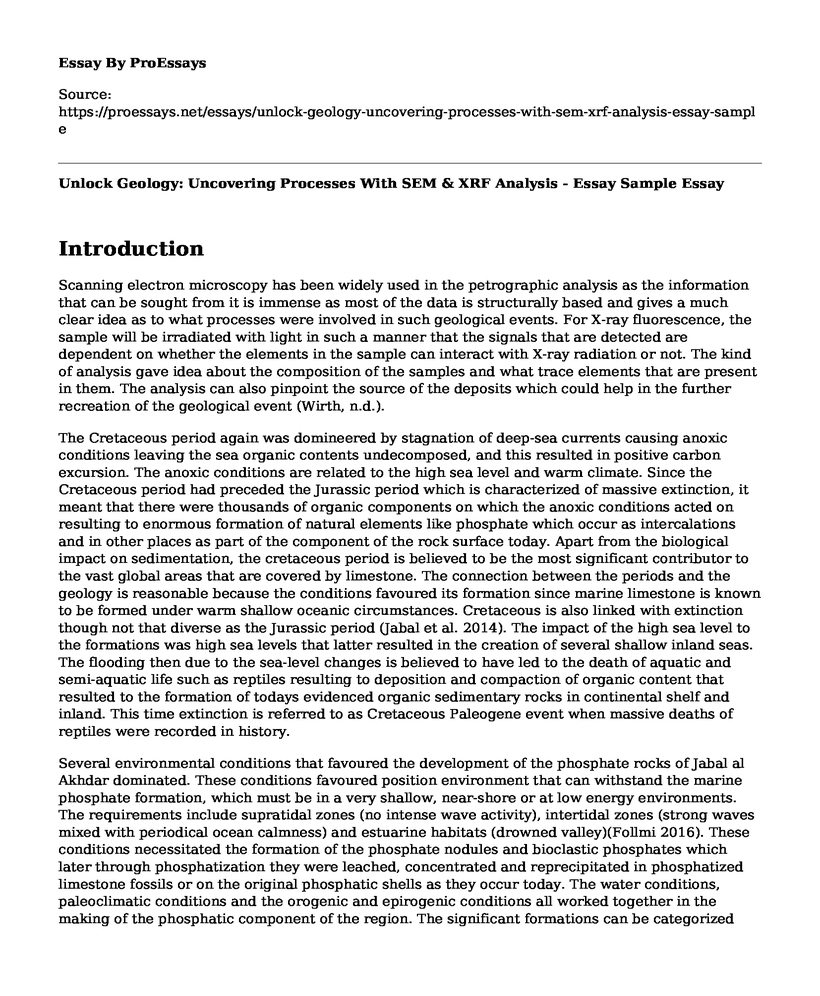Introduction
Scanning electron microscopy has been widely used in the petrographic analysis as the information that can be sought from it is immense as most of the data is structurally based and gives a much clear idea as to what processes were involved in such geological events. For X-ray fluorescence, the sample will be irradiated with light in such a manner that the signals that are detected are dependent on whether the elements in the sample can interact with X-ray radiation or not. The kind of analysis gave idea about the composition of the samples and what trace elements that are present in them. The analysis can also pinpoint the source of the deposits which could help in the further recreation of the geological event (Wirth, n.d.).
The Cretaceous period again was domineered by stagnation of deep-sea currents causing anoxic conditions leaving the sea organic contents undecomposed, and this resulted in positive carbon excursion. The anoxic conditions are related to the high sea level and warm climate. Since the Cretaceous period had preceded the Jurassic period which is characterized of massive extinction, it meant that there were thousands of organic components on which the anoxic conditions acted on resulting to enormous formation of natural elements like phosphate which occur as intercalations and in other places as part of the component of the rock surface today. Apart from the biological impact on sedimentation, the cretaceous period is believed to be the most significant contributor to the vast global areas that are covered by limestone. The connection between the periods and the geology is reasonable because the conditions favoured its formation since marine limestone is known to be formed under warm shallow oceanic circumstances. Cretaceous is also linked with extinction though not that diverse as the Jurassic period (Jabal et al. 2014). The impact of the high sea level to the formations was high sea levels that latter resulted in the creation of several shallow inland seas. The flooding then due to the sea-level changes is believed to have led to the death of aquatic and semi-aquatic life such as reptiles resulting to deposition and compaction of organic content that resulted to the formation of todays evidenced organic sedimentary rocks in continental shelf and inland. This time extinction is referred to as Cretaceous Paleogene event when massive deaths of reptiles were recorded in history.
Several environmental conditions that favoured the development of the phosphate rocks of Jabal al Akhdar dominated. These conditions favoured position environment that can withstand the marine phosphate formation, which must be in a very shallow, near-shore or at low energy environments. The requirements include supratidal zones (no intense wave activity), intertidal zones (strong waves mixed with periodical ocean calmness) and estuarine habitats (drowned valley)(Follmi 2016). These conditions necessitated the formation of the phosphate nodules and bioclastic phosphates which later through phosphatization they were leached, concentrated and reprecipitated in phosphatized limestone fossils or on the original phosphatic shells as they occur today. The water conditions, paleoclimatic conditions and the orogenic and epirogenic conditions all worked together in the making of the phosphatic component of the region. The significant formations can be categorized into the famous Rayda and Salil formation that underly the area, as shown in the picture below. The establishment of the limestone base layer that is shown below relates to the Jurassic period while the organic composition is related to the orogeny that occurred in between late Jurassic and early cretaceous period resulting to the subduction of the settled organic materials commonly associated with bioturbation.
Figure SEQ Figure \* ARABIC 13 shows the major stratigraphy of the area
Figure 13 shows the major stratigraphy of the area (Celestino et al. 2017).
Impact of Condensation
The term condensation as used in geology has been ambiguous since time immemorial(Follmi 2016). As (Follmi 2016) illustrates, a straight and unambiguous definition should be developed in the studies relating to sediment deposition. He additionally defines condensed sediments as thin beds of centimeter and decimeter width measurement formed during extremely long periods. Phosphates are ranked among the composition of composed sediments with other elements being precipitations of carbonates, iron, magnesium, Verdine, glaucony, among others. In geologic studies, condensed sediments have been used to trace palaeoceanographic and paleoenvironmental proxies as they usually result from changes related to these two geologic factors. The research therefore utilized the sedimentation of the phosphate sediments occurring pristine (phosphates that have not undergone bioturbation), condensed (formed from sedimentary condensation process) and Allochthonous (phosphatic particles that were formed via turbulent driven flows or gravity driven flows) all to relate to palaeoceanographic and paleoenvironmental conditions and arrive to a conclusion. Out of the study and relating to documentation concerning phosphate concentration, it was found out that the concentration of the phosphate rich layers in ferromanganese in the area is out of suitable climatic conditions and other favourable conditions of the late Jurassic and Cretaceous periods that accelerated phosphorous cycling and precipitation.
References
Knaust, D. 2012. "Classification of Bioturbation-Related Reservoir Quality in the Khuff Formation ( Middle East ): Towards a Genetic Approach." 247-67.
Kurcinka, By Colleen. n.d. "Technical Bulletin Geological Results with the Scanning Electron Microscopy ( SEM ):"
Searle, Michael P. 2016. "Preserving Oman ' s Geological Heritage : Proposal for Establishment of World Heritage Sites , National GeoParks and Sites of Special
Cite this page
Unlock Geology: Uncovering Processes With SEM & XRF Analysis - Essay Sample. (2023, May 06). Retrieved from https://proessays.net/essays/unlock-geology-uncovering-processes-with-sem-xrf-analysis-essay-sample
If you are the original author of this essay and no longer wish to have it published on the ProEssays website, please click below to request its removal:
- Foundation of Jamestown
- Challenges and Methods of Archeology: Essay Sample
- Essay Sample on Math Education: Developing Procedural & Conceptual Understanding
- Paper Example on Germany vs. Poland Comparison
- Snow Earth: Cause of Cambrian Explosion? - Essay Sample
- Essay Example on Understand Wave: Longitudinal & Transverse Types, Properties, & More
- Essay Example Air Quality Studies: Gaussian Plume & Box Models







